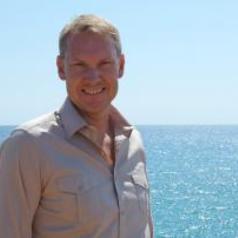Professor Johan Hollander, a marine biologist at the World Maritime University | Sasakawa Global Ocean Institute in Malmö, Sweden is the co-PI with Reef Conservation but manages several other research projects in the Indian Ocean and Sweden and shares some insightful information about seagrass.
It seems like the interest in seagrass ecosystems is currently at an all-time high, with seagrass meadows being recognized to be of global significance both to our climate and food security. What would be the role of seagrasses in fighting the twin crises of climate change and biodiversity loss?
It is correct that seagrasses have gained less attention but that is slowly changing now – most because we start to understand all the benefits and ecosystem services seagrass meadows provide. Seagrasses are more than just a species on its own, it is a functional species meaning that it provides home, shelter, and food for other species. In other words, seagrasses are instrumental for biodiversity, and when we are losing seagrass meadows, we also losing associated species – eroding biodiversity.
With ocean climate change, we will see sea-level rise, ocean acidification and other negative effects on the marine environment. Seagrasses can help us to protect the shore, since seagrass roots binding the sediment, and can thus mitigate the risk of coastal erosion from sea-level rise and stronger and more frequent storms. Since seagrasses are primary producer, its photosynthesizing reducing CO2 and produce oxygen. It has lately been shown that seagrass meadows are also highly effective to sequestrating CO2 into the sediment. For that reason, seagrasses are essential to protect as they are functioning as an important carbon sink.
With the increasing realization of the planetary emergency that we face, and growing interest in using seagrasses as a nature-based solution for protecting the coastal zones, what threats are compromising the ecological state of seagrasses?
Threats to seagrasses differ to some extent depending on where you are in the world. But some of the obvious threats are the use of unsustainable fishing methods, eutrophication which are excessive levels of nutrients in the water, land reclamation which release large quantities of silt in the water, making photosynthesizing difficult when the water is not clear.
Improved protection and restoration of seagrasses require better recognition of the role that they play in supporting people and our planet… What would we need to improve and catalyze action to halt and reverse seagrass loss? Would connecting these actions to the daily actions and needs of people, institutions and communities through the UN SDGs framework be a solution?
At many places around our globe, seagrasses would need stronger and more effective legal protection. Sometimes their legal status could be high, but the power and capacity to implement this protection is low. For example, in some countries, seagrasses are protected by legal instruments, but where we still experience dynamite fishing within the meadows.
World Maritime University and Sodertorn University are partners of Reef Conservation on this major EU funded project being implemented in Mauritius. What is the aim of this project in Mauritius and what expertise do you bring in on this project?
The project has a strong focus on multidisciplinary, which only reflect how many disciplines and areas seagrasses cover. For example, we have a specific social science expert only working on peoples and coastal businesses perceptions about seagrasses, and their role in coastal erosion. We have also involved climate scientists which have the expertise to build theoretical models explaining the consequences if we are losing seagrass meadows. The project also using the latest molecular technique, so called eDNA (environmental-DNA), where only a water sample from a meadow, can provide information what fish and other species are present in the meadow. With eDNA we can sample across many years to see if, for example the fish community in a specific meadow, is increasing or decreasing. For social-economic reasons, this is of high relevance, since many of our economically important fish species are using seagrasses as nurseries.
Which sites have been identified in Mauritius for seagrass restoration and when is restoration starting? What type of restoration technique will you be using?
At this point, we have identified Mont Choisy, and Bel Ombre as potential good sites for restorations. We are planning to initiate test plantations early next year, and hopefully we can start the larger restorations around October 2023. It is however important to point out, we are not doing these restorations to restore certain sites, but the aim of the project is to work out a best practice (a guide) how to carry out seagrass restorations in Mauritius. Since our experience of seagrass restorations from other parts around the world tell us that planting techniques are site specific, we will examine many different techniques to learn which technique is working best in Mauritius.
You can find out more about Professor Hollander’s research here: http://www.marinescience2.wixsite.com/johanhollander
Header photography credit : theoceanagency.org

